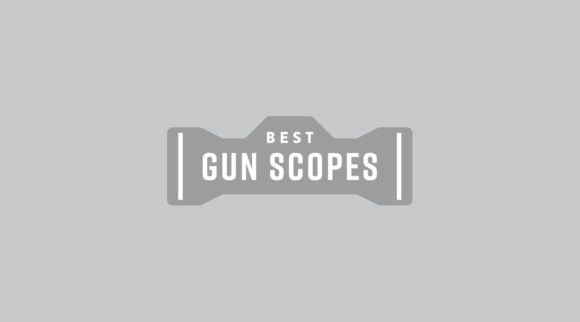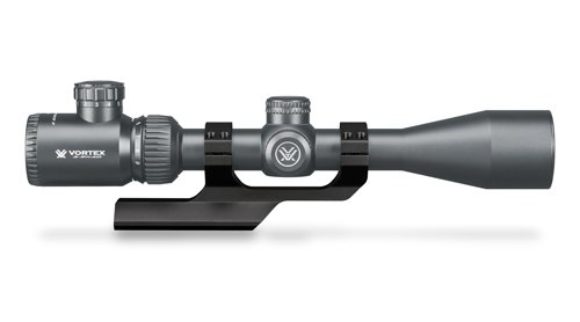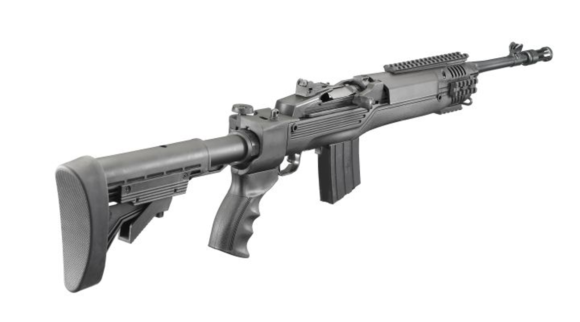Best Rimfire Scope Reviews 2022: Top Rated Leupold and Nikon Optics for .22 LR

There’s no question that rimfire rifles are a worthy addition to any gun cabinet. Of course, you’ll need a good scope to complement your rimfire gun. There are hundreds of scopes available online, but you want to spend time shooting, not shopping! It takes time to sort out your requirements and to compare scopes. That’s where we come in.
We went looking for the best rimfire scopes available online. We consulted hunting magazines, online shooting forums, and read hundreds of buyer reviews from other hunters.
We’ve come up with 3 great options just for rimfire rifles, which will complement your gun and save you money!
You’ll find our full, in-depth reviews of each of these scopes on this page. We’ve broken down all the key features and collected all the important specs to save you time and effort. At the bottom of the page, you’ll also find some pointers on shopping for a rimfire scope.
Here’s a quick snapshot of the best rimfire scopes:
| Category | Image | Product | |
|---|---|---|---|
| Best Value | Nikon P-Rimfire | Check Price | |
| Best Quality | Vortex Crossfire II Rimfire | Check Price | |
| Best Seller | Leupold VX-Freedom | Check Price |
In this Guide
Top Related Article – Best Rifle Scopes For Your Money
Best Rimfire Scope Reviews
Nikon P-Rimfire
Check Price On Amazon
The ProStaff Rimfire is simple and no-frills, but Nikon has a very good reputation for quality glass and precise adjustment knobs. An overwhelming number of reviewers gave this one 5 stars, and it’s also a top seller and recommendation on other hunting sites! The BDC reticle makes it easy to make precise shots, and you’ll have plenty of range to reach out for longer targets. It’s definitely the best budget choice for a rimfire scope!
Pros:
This Nikon scope has a standard 3-9X power range, which gives you a nice balance between magnification power and low-end field of vision. You’ll be able to make shots out to 500 yards, without losing the ability to shoot up close.
It’s built for the modern age, with computer engineered lenses, and environmentally sound construction materials. The glass and housing is free of arsenic and lead, and uses aluminum to strike a balance between strength and weight.
Even without traditional chemical compounds, Nikon’s EcoGlass provides a non-reflective view with minimal loss of light. Both lenses are fully multi-coated, and previous buyers were very impressed by how bright the scope is for the price.
The tube is completely sealed for air and moisture proofing, and filled with nitrogen gas. There are also O-rings to seal the ends. That’s solid build quality for under $200!
The BDC reticle comes with drop markings for 50, 100, and 150 yards. That gives you good control over a standard rimfire range. It’s also calibrated to work with .22 ammo, so you have precise measurements for the specific cartridge.
We particularly like that the drop markings are open circles, rather than cross marks. That lets you get a focus on your target without obscuring anything in your field of vision.
The scope is set to be parallax-free at 50 yards. Beyond that, there are two adjustment turrets, for windage and elevation. We like them because they’re simple, easy to use, and have very definite clicks when you make adjustments.
Both the adjustment turrets and the reticle are coordinated with Nikon’s Spot On app, which helps you make complicated ballistics calculations without needing a pen and paper, or mental math skills.
It’s very inexpensive. The Nikon is a good way to get a high-quality glass that won’t out-spend your rifle class. Many said it was easily the best they’d ever seen in this price range.
Cons:
The parallax setting isn’t adjustable independently of the other adjustment turrets. That isn’t much of a problem at lower ranges, and we didn’t find any complaints about parallax online. However, some more technical shooters might find the Nikon lacking in this regard.
It won’t work on bigger guns. Some hunters wanted to use it on a few rifles, and were disappointed by the top end of the power range. We haven’t recommended any super high-power scopes here, since rimfire rifles are generally a close- to mid-range weapon.
Some purists online have written in their reviews that the BDC calculations are based on 1600fps ammunition specs. They point out that .22 bullets rarely hit that speed. That’s certainly true, but we couldn’t find any complaints from hunters who used it in the field. In our book, it’s a non-issue.
2. Vortex Crossfire II Rimfire
Check Price On AmazonIf it ain’t broke, don’t fix it. That old adage is the basic approach to this scope. Vortex Optics has quickly become the one of the leaders in the optics industry, and this Crossfire II rimfire scope is no different. They’ve tinkered with the finer workings of a well-loved design to keep it current but classic. This one is similar to the Nikon in terms of power, but has a slightly wider field of vision. It also has better build quality, and is backed by excellent customer service and Vortex Optics unmatched VIP Lifetime Warranty. We’re impressed by its bright, clear imaging, as well as the incredibly reliable zero-focus.
Pros:
From the first glance, the Vortex Crossfire II Rimfire is a beauty. It’s sleek, streamlined, and minimalist. It’ll suit nearly any gun, from a wooden parlor piece to a modern, matte finish black rifle.
With a 2-7X magnification range, the Crossfire II Rimfire provides a comparable power scale to most other rimfire scopes. It gives you a bit less reach than the Nikon, while maintaining that important low-end focus and a wide field of vision. There is a wide eye box and plenty of eye relief.
Between the lenses, there’s a sealed canister complete with O-rings and a new Argon/Krypton water and fog proofing system. This improves the scope’s resistance to thermal shock (an issue with nitrogen sealant).
It also has a simple V-plex reticle, so there’s very little technical interference (this makes it easier if you’re a novice or prefer iron sights, but want a bit more range). The crosshairs are bold on the edges (helpful for low light) and narrow down in the center for precision shooting. There’s no school like the old school!
The adjustment turrets are very low-profile. We love that they’re unobtrusive visually, and aren’t exposed enough to risk being bumped or jostled accidentally. The adjustments are simple, but precise. They work at 1/4 click MOA, for standard ballistics calculations.
The Vortex Crossfire II Rimfire is really all about the glass, and reviewers said it’s very clear and bright, and they had no problems with it whatsoever. Both lenses are fully multi-coated, and blackened at the edges to prevent glare and diffusion. Reviewers also said it works very well in low-light conditions.
Over 90% of reviewers on Amazon gave the scope 5 stars! They praised its reliability, ease of use, and clear glass. The Crossfire II Rimfire was their favorite all-around, all-purpose scope, and many buyers had owned theirs for several decade with no problems whatsoever. It’s a classic for a reason.
The Rimfire II is insured for life. Vortex Optics is well known for their VIP Lifetime Warranty program, where you can get your scope replaced for practically any reason – even if it’s your fault in some cases.
It’s not a gimmick, either. Reviewers consistently praise Vortex Optics’s customer service and coverage. They said that once they bought their first model from the company, they were buyers
Cons:
It’s not terribly sophisticated. More tactical shooters might be disappointed by the simplicity of the reticle. There aren’t mil-dot markings, or bullet drop circles.
For those buyers, we’d advise looking for one of the other models on our list. They’re available for around the same price point online.
Leupold VX-Freedom
Check Price On Amazon
The VX-Freedom is designed to be an affordable but effective rimfire scope. It’s a modernized version of a classic, with a best-selling design, eco-friendly materials, and advanced lenses. The big difference from the VX-2 is the lens pairing, which has a lower-end power and narrower objective. It’s better for close-range hunting, and the lenses also help bring the price down. Reviewers on multiple sites recommended this one highly, and it’s been one of Leupold’s top sellers for years! It has excellent workmanship, great visuals, and a very reasonable price.
Pros:
The VX-Freedom has been updated for the more environmentally-conscious modern world. The glass and metal parts, as well as the coatings, are all free of lead.
The 33 mm canister is a stronger, slimmer design than traditional 1” scopes. It has greater structural integrity and is sealed with argon/krypton gases, much like the VX-2.
The VX-Freedom has a similar power range than the VX-2, with a 3-9X coverage. That gives you even more room for adjustment at close quarters and complements the ideal range of rimfire cartridges.
In keeping with the modern approach, the lenses are also now computer analyzed for flaws, and fully multi-coated for clarity and glare reduction. They’re better than previous generations of the VX-Freedom at maintaining color balance and full light coverage at the target area.
We especially love the locking fast-focus eyepiece. You can quickly get a focus at any zoom setting, and lock it down for each shot. The lock is a smart advantage over other quick-focus pieces, since it’s easy to brush these parts by accident.
The adjustment turrets are simple but effective, with a knob each for windage and elevation. Both operate at 1/4 MOA per click. The knobs are low-profile and unobtrusive, which we especially love! Since rimfire rifles are generally used at close range, you’ll be moving through brush and branches pretty frequently.
Most of all, previous buyers praised the glass, citing its clarity, color transmission, and light spread among the factors that made it superior to other scopes in this price range.
The VX-Freedom is especially nice because it brings the quality and clarity of the Leupold a bit closer to the Bushnell/Nikon price range. People who said they switched were really happy with the results. In terms of both light translation and clarity, they said that the Leupold made hunting at the beginning and end of the day the clear choice.
Cons:
Some reviewers said the adjustment knobs felt a bit cheap. They said that while they were precise and had definite clicks, they felt lighter and less reassuring than other models from Leupold.
Like the VX-2, it’s not very technical. We’re recommending both these scopes because rimfire shooters tend not to be making longer shots.
Conclusion
Which rimfire scope is right for you?
The Nikon is our budget choice, since it’s so versatile and inexpensive. The 3-9X power ratio should cover all your needs with a rimfire rifle, and Nikon’s build quality and warranty coverage are excellent for the price. It’s also the only adjustable scope here. We think it’s the best choice for folks who want to be able to make plenty of adjustments. It’s a good choice for people who are learning on a rimfire weapon, since their scope skills will be transferable to any center-fire scope.
Both the VX-1 and VX-2 from Leupold have fairly similar build quality. They’re a step above the Nikon, with improved waterproofing and fog-proofing. Plus, they’re both built in the U.S. and covered by Leupold’s legendary customer service.
The VX-1 is the better choice for close-range shooting, since its lens set has a lower power range, and closer adjustments within 500 yards. If you don’t tend to go out beyond that distance, there’s no reason to spend more for the VX-2.
The VX-2 adds a bit more magnification power, and is a good all-purpose upgrade along the same spec lines as the Nikon. If you want some more range, or are fitting to a larger weapon, it’s worth the extra bucks.
As we’ve said in the reviews, the Leupold models aren’t the most technical scopes. They’re fixed, so they’re much more limited in terms of the range of adjustments you can make with them. If you’re a more technical shooter, or are looking to make longer shots, the Nikon is probably the best choice for you. It has a fairly wide power range, and the BDC reticle is ideal for those longer shots. It’s also specific to .22 ammo.
On the other hand, the Leupold scopes are more than adequate for most shots within a rimfire range. They’re also engineered more precisely and with a higher level of clarity than you get with the Nikon. We generally prefer them, but fixed-magnifications scopes aren’t for everyone. If you like a more modern eyepiece, the Nikon is a perfectly worthy option.
How to Shop for The Best Rimfire Scope
Make sure the scope suits the caliber of your rifle:
Rimfire cartridges fire .22 and .17 caliber bullets. They’re both suitable for target practice, short range hunting, and small caliber guns. The key advantages of the either rimfire cartridge are lesser kickback and pressure outward, less noise, and much smaller amount of powder used.
.22 caliber rifles are by far the most common, so that’s what we’ve catered to here. All three of our choices are ideal for the .22. If you’re shooting with a .17 caliber rifle, the Leupold models above will certainly suit your needs. The Nikon will also work, but the BDC markings aren’t measured for .17 ammo, so they won’t work very precisely for you.
Consider your budget:
There’s a common misconception that rimfire rifles can be fitted with cheaper scopes, since they produce less kickback. That’s not strictly true. While rimfire rifles produce less kickback than central-fire models, they tend to be shot more often. Since you’re paying less per round, you’re more likely to use more for practice and fun shooting. All that usage adds up, even if each shot isn’t necessarily as hard on your gun as it would at a larger caliber.
So, durability is just as important. We caution against going with a super low-priced model under $100, as they tend to be too delicate and unreliable. You should apply the same standards of quality to a rimfire scope as you would to a centerfire rifle scope.
Overall, models specifically designed for rimfire guns tend to be cheaper, between $100-$500. However, there are some premium scopes available which have adjustable caliber settings. These tend to be at least $1,000.
Look for lower power:
Rimfire ammo generally isn’t very good at long range. Rimfire bullets are small, so they don’t have the power or punch you need to hunt long-distance. Don’t bother spending money on something with a lot of magnification power you won’t
Try to find a scope with a moderate range, but a range that starts lower (around 1-4X). A standard 3-9X range is a good choice for both rimfire and centerfire cartridges. Scopes starting at 4-6X won’t serve your rimfire rifle as well.
Decide between fixed and adjustable scopes:
Fixed magnification scopes aren’t given the appreciation they deserve! Sure, they won’t help you much for long-range shooting, but they’re ideal for rimfire weapons. Since most gun owners have at least one .22 or other rimfire caliber gun, a fixed piece is well-worth consideration. They provide all the power you need to use these weapons at their usable range, and they’re set to be parallax-free at just about the point when your eyesight starts getting iffy (~50 yards). That’s suitable for plinking and small game hunting.
Still, if you’re going to be pushing a rimfire rifle to longer distances and doing some tough target shooting, it’s best to go with an adjustable model. These have adjustable lenses, and some have a separate knob for parallax compensation. You’ll pay more for them, but they’ll be more versatile in the field.
Why we love rimfire weapons:
Rimfire bullets were actually the first cartridge ammunition to be invented, and have remained popular even after the invention and rise of centerfire bullets. Why?
One reason is they’re cheap to manufacture. They use less powder, thanks to their smaller powder chamber. They also use less brass in the shell, because the walls need to be thin (in order to be crushed and fired). Rimfire rifles also tend to be less expensive, so the whole operation is budget-friendly! Read more on Rimfire vs Centerfire.
Their economic advantage makes rimfire rifles a great choice for practice, pest control, and budget-minded hunters. Since the guns and cartridges are lighter, they’re easier to carry for a day in the field or at the range. You can also practice longer before your arms get too tired!
What’s Next?
Keep reading for more of our recommendations for the best gun scopes! We have reviews for the best .22 scopes, best night vision scopes, and more. Check out quick summaries of each category on our main page.











